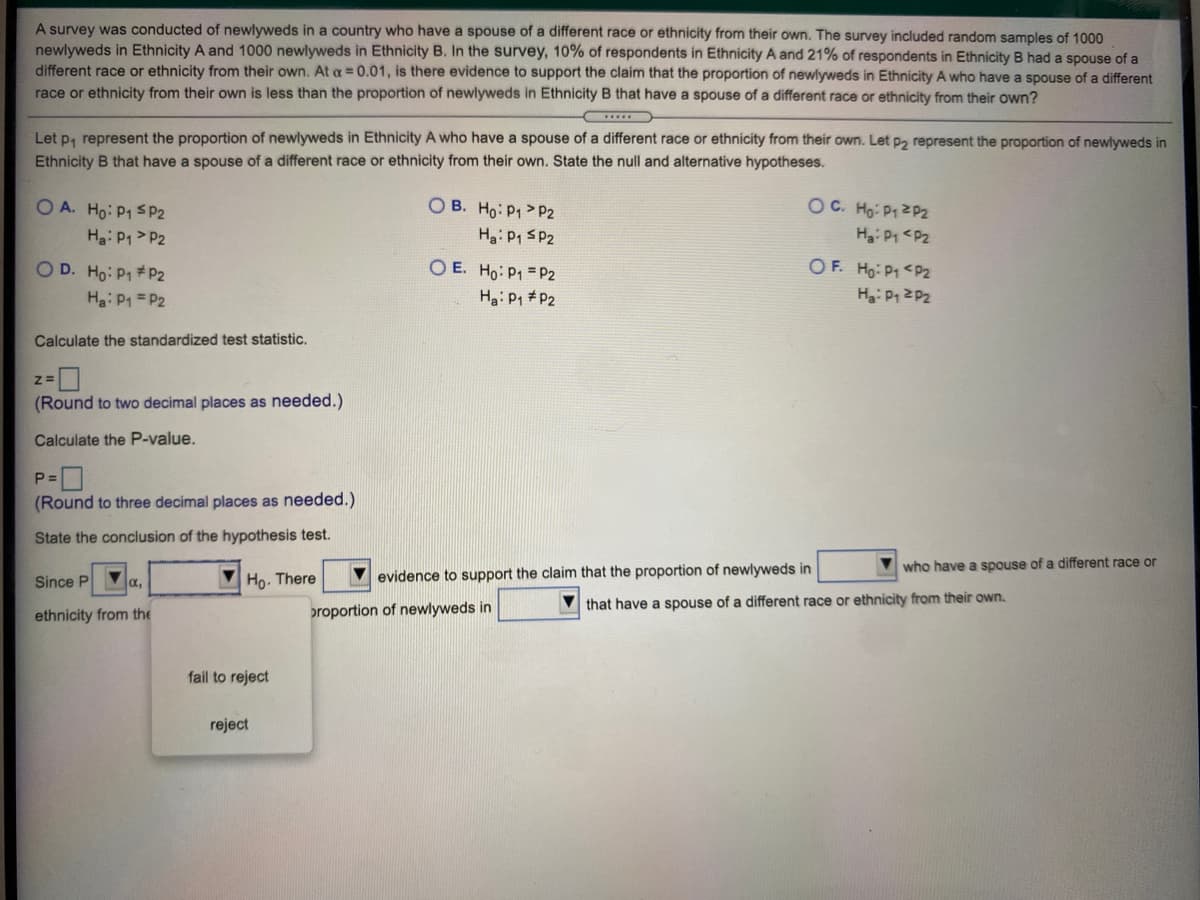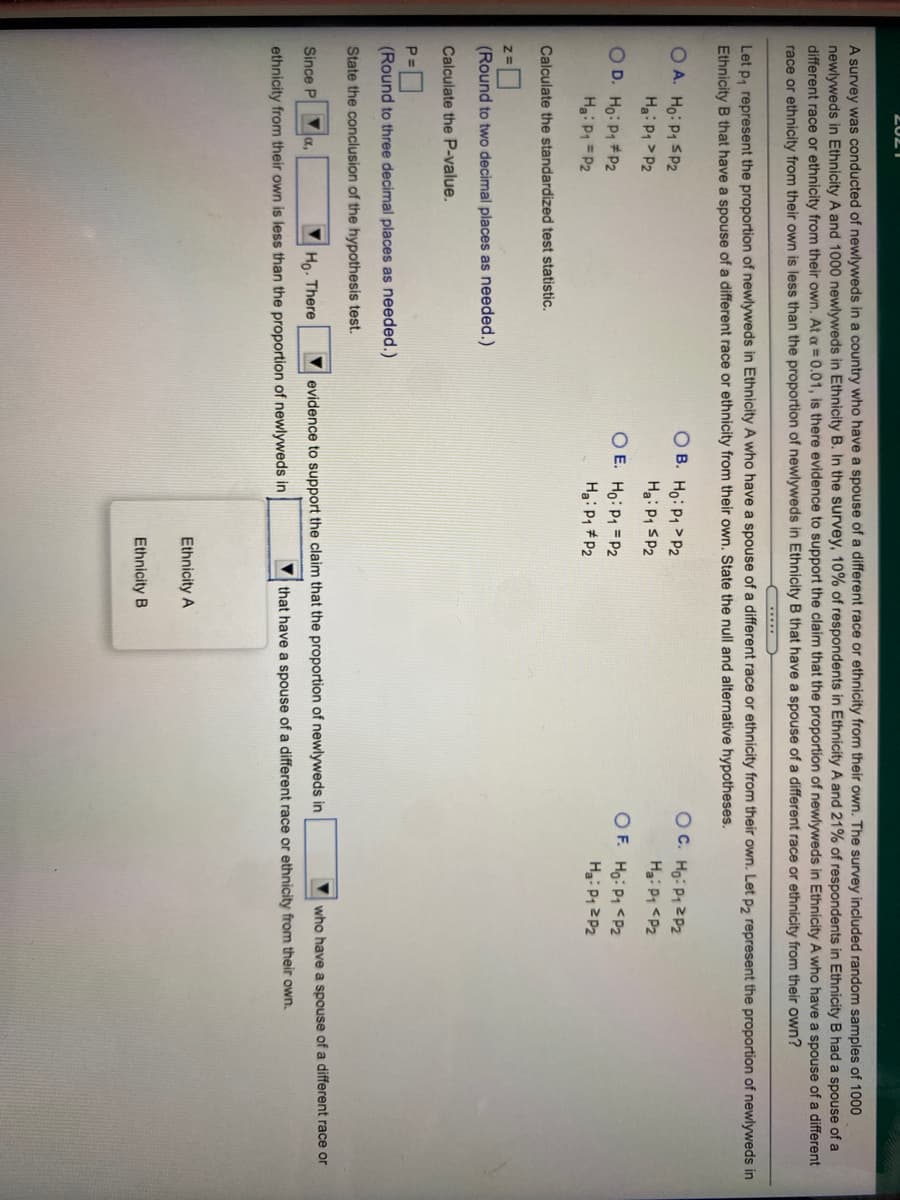A survey was conducted of newlyweds in a country who have a spouse of a different race or ethnicity from their own. The survey included random samples of 1000 newlyweds in Ethnicity A and 1000 newlyweds in Ethnicity B. In the survey, 10% of respondents in Ethnicity A and 21% of respondents in Ethnicity B had a spouse of a different race or ethnicity from their own. At a =0.01, is there evidence to support the claim that the proportion of newlyweds in Ethnicity A who have a spouse of a different race or ethnicity from their own is less than the proportion of newlyweds in Ethnicity B that have a spouse of a different race or ethnicity from their own? Let p, represent the proportion of newlyweds in Ethnicity A who have a spouse of a different race or ethnicity from their own. Let p2 represent the proportion of newlyweds im Ethnicity B that have a spouse of a different race or ethnicity from their own. State the null and alternative hypotheses. O B. Ho: P1 > P2 O A. Ho: P1 SP2 Hg: P1 > P2 OC. Ho: P1ZP2 Hi Pr
A survey was conducted of newlyweds in a country who have a spouse of a different race or ethnicity from their own. The survey included random samples of 1000 newlyweds in Ethnicity A and 1000 newlyweds in Ethnicity B. In the survey, 10% of respondents in Ethnicity A and 21% of respondents in Ethnicity B had a spouse of a different race or ethnicity from their own. At a =0.01, is there evidence to support the claim that the proportion of newlyweds in Ethnicity A who have a spouse of a different race or ethnicity from their own is less than the proportion of newlyweds in Ethnicity B that have a spouse of a different race or ethnicity from their own? Let p, represent the proportion of newlyweds in Ethnicity A who have a spouse of a different race or ethnicity from their own. Let p2 represent the proportion of newlyweds im Ethnicity B that have a spouse of a different race or ethnicity from their own. State the null and alternative hypotheses. O B. Ho: P1 > P2 O A. Ho: P1 SP2 Hg: P1 > P2 OC. Ho: P1ZP2 Hi Pr
Holt Mcdougal Larson Pre-algebra: Student Edition 2012
1st Edition
ISBN:9780547587776
Author:HOLT MCDOUGAL
Publisher:HOLT MCDOUGAL
Chapter11: Data Analysis And Probability
Section: Chapter Questions
Problem 8CR
Related questions
Concept explainers
Equations and Inequations
Equations and inequalities describe the relationship between two mathematical expressions.
Linear Functions
A linear function can just be a constant, or it can be the constant multiplied with the variable like x or y. If the variables are of the form, x2, x1/2 or y2 it is not linear. The exponent over the variables should always be 1.
Question
12 solve all parts please

Transcribed Image Text:A survey was conducted of newlyweds in a country who have a spouse of a different race or ethnicity from their own. The survey included random samples of 1000
newlyweds in Ethnicity A and 1000 newlyweds in Ethnicity B. In the survey, 10% of respondents in Ethnicity A and 21% of respondents in Ethnicity B had a spouse of a
different race or ethnicity from their own. At a 0.01, is there evidence to support the claim that the proportion of newlyweds in Ethnicity A who have a spouse of a different
race or ethnicity from their own is less than the proportion of newlyweds in Ethnicity B that have a spouse of a different race or ethnicity from their own?
Let p, represent the proportion of newlyweds in Ethnicity A who have a spouse of a different race or ethnicity from their own. Let p2 represent the proportion of newlyweds in
Ethnicity B that have a spouse of a different race or ethnicity from their own. State the null and alternative hypotheses.
O B. Ho: P1 P2
Hai P1 SP2
O C. Ho: P1ZP2
O A. Ho: P1 S P2
Ha: P1 > P2
OD. Ho: P1 #P2
O E. Ho: P1 = P2
O F. Ho: P1 <P2
Ha: P1 = P2
Ha: P1 #P2
Hgi Pr Z P2
Calculate the standardized test statistic.
(Round to two decimal places as needed.)
Calculate the P-value.
(Round to three decimal places as needed.)
State the conclusion of the hypothesis test.
who have a spouse of a different race or
Since P
V Họ. There
evidence to support the claim that the proportion of newlyweds in
that have a spouse of a different race or ethnicity from their own.
ethnicity from the
proportion of newlyweds in
fail to reject
reject

Transcribed Image Text:A survey was conducted of newlyweds in a country who have a spouse of a different race or ethnicity from their own. The survey included random samples of 1000
newlyweds in Ethnicity A and 1000 newlyweds in Ethnicity B. In the survey, 10% of respondents in Ethnicity A and 21% of respondents in Ethnicity B had a spouse of a
different race or ethnicity from their own. At a = 0.01, is there evidence to support the claim that the proportion of newlyweds in Ethnicity A who have a spouse of a different
race or ethnicity from their own is less than the proportion of newlyweds in Ethnicity B that have a spouse of a different race or ethnicity from their own?
Let p, represent the proportion of newlyweds in Ethnicity A who have a spouse of a different race or ethnicity from their own. Let p2 represent the proportion of newlyweds in
Ethnicity B that have a spouse of a different race or ethnicity from their own. State the null and alternative hypotheses.
O A. Ho: P1 SP2
O B. Ho: P1 > P2
O C. Ho: P1ZP2
Ha: P1 > P2
Hg: P, SP2
O E. Ho P1 =P2
OF. Ho P1 <P2
OD. Ho: P1 #P2
Ha: P1 = P2
Hai P1 #P2
Hg: P1 2P2
Calculate the standardized test statistic.
(Round to two decimal places as needed.)
Calculate the P-value.
P
(Round to three decimal places as needed.)
State the conclusion of the hypothesis test.
who have a spouse of a different race or
Since P
Ho. There
evidence to support the claim that the proportion of newlyweds in
that have a spouse of a different race or ethnicity from their own.
ethnicity from their own is less than the proportion of newlyweds in
Ethnicity A
Ethnicity B
Expert Solution
This question has been solved!
Explore an expertly crafted, step-by-step solution for a thorough understanding of key concepts.
This is a popular solution!
Trending now
This is a popular solution!
Step by step
Solved in 2 steps with 3 images

Knowledge Booster
Learn more about
Need a deep-dive on the concept behind this application? Look no further. Learn more about this topic, statistics and related others by exploring similar questions and additional content below.Recommended textbooks for you

Holt Mcdougal Larson Pre-algebra: Student Edition…
Algebra
ISBN:
9780547587776
Author:
HOLT MCDOUGAL
Publisher:
HOLT MCDOUGAL

Algebra & Trigonometry with Analytic Geometry
Algebra
ISBN:
9781133382119
Author:
Swokowski
Publisher:
Cengage

Glencoe Algebra 1, Student Edition, 9780079039897…
Algebra
ISBN:
9780079039897
Author:
Carter
Publisher:
McGraw Hill

Holt Mcdougal Larson Pre-algebra: Student Edition…
Algebra
ISBN:
9780547587776
Author:
HOLT MCDOUGAL
Publisher:
HOLT MCDOUGAL

Algebra & Trigonometry with Analytic Geometry
Algebra
ISBN:
9781133382119
Author:
Swokowski
Publisher:
Cengage

Glencoe Algebra 1, Student Edition, 9780079039897…
Algebra
ISBN:
9780079039897
Author:
Carter
Publisher:
McGraw Hill